Asilidae
The Asilidae are the robber fly family, also called assassin flies. They are powerfully built, bristly flies with a short, stout proboscis enclosing the sharp, sucking hypopharynx.[1][2] The name "robber flies" reflects their notoriously aggressive predatory habits; they feed mainly or exclusively on other insects and as a rule they wait in ambush and catch their prey in flight.
| Asilidae | |
|---|---|
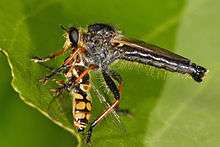 | |
| Zosteria sp. | |
| Scientific classification | |
| Kingdom: | Animalia |
| Phylum: | Arthropoda |
| Class: | Insecta |
| Order: | Diptera |
| Suborder: | Brachycera |
| Infraorder: | Asilomorpha |
| Superfamily: | Asiloidea |
| Family: | Asilidae Latreille, 1802 |
| Subfamilies | |
| |
Overview


The Asilidae are a family in the order Diptera, the true flies. The common name for members of the family is the robber flies. The Asilidae are cosmopolitan, with over 7000 described species. Latreille was the authority for establishing the family in 1802.[3] The Asilidae, together with Bombyliidae and Therevidae, are the most representative families of the superfamily of Asiloidea and they form one of the most characteristic groups of the lower Brachycera.
Robber flies have stout, spiny legs and they have three simple eyes (ocelli) in a characteristic depression on the top of their head between their two large compound eyes.[4] They also have a usually dense moustache of stiff bristles on the face; this is called the mystax, a term derived from the Greek mystakos meaning "moustache" or "upper lip". The mystax has been suggested to afford some protection for the head and face when the flies deal with struggling prey; various Asilidae prey on formidable species including stinging Hymenoptera, powerful grasshoppers, dragonflies and even other Asilidae, in fact practically anything of a suitable size. Some Asilidae do, however, specialize in smaller prey, and this is reflected in their more gracile build.
In general the family attacks a very wide range of prey, including other flies, beetles, butterflies and moths, various bees, ants, dragon and damselflies, ichneumon wasps, grasshoppers, and some spiders. They do so apparently irrespective of any repugnatorial chemicals the prey may have at its disposal.[5] Many Asilidae when attacked in turn do not hesitate to defend themselves with their proboscides and may deliver intensely painful bites if handled incautiously.
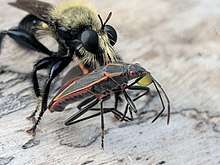
The antennae are short, have three segments, and sometimes bear a bristle-like structure called an arista.
Though they are a very characteristic group for such a large family, the Asilidae may easily be confused with the related and less widely known family Therevidae. Some points of contrast between the families include that the labium in the Therevidae is not a piercing, predatory organ, but ends in two fleshy labella adapted to the sucking of liquid foods. Again, the Therevidae commonly have fluffy setae above the mouthparts, unlike the stiff chaetae comprising the mystax of the Asilidae. Furthermore, in the Asilidae the depression on the vertex between the eyes tends to be more obvious than in the Therevidae.
The fly attacks its prey by stabbing it with its short, strong proboscis, injecting the victim with saliva containing neurotoxic and proteolytic enzymes which very rapidly paralyze the victim and soon digest the insides; the fly then sucks the liquefied material through the proboscis.
Many Asilidae have long, tapering abdomens, sometimes with a sword-like ovipositor. Others, for instance Laphria, are fat-bodied bumblebee mimics.
Female robber flies deposit whitish-colored eggs on low-lying plants and grasses, or in crevices within soil, bark, or wood. Egg-laying habits depend on the species and their specific habitat; most species lay their eggs in masses, which are then covered with a chalky protective coating.
After hatching, robber fly larvae generally seem to live in soil, rotting wood, leaf mold and similar materials, some being predatory and others detrivorous.[5] Larvae are also predacious, feeding on eggs, larvae, or other soft-bodied insects. Robber flies overwinter as larvae and pupate in the soil. Pupae migrate to the soil surface and emerge as adults, often leaving behind their pupal casing. Complete development ranges from one to three years, depending on species and environmental conditions.[6]
Morphology
Adult
Adults are generally medium to large in size, with an average body width of 1 to 1.5 cm but with a range of 3 cm to more than 5 cm in length. The shape is generally elongated, due to the conformation of the long tapering abdomen, however there are also compact species with broad abdomens. The integument is covered with thick hair, especially on the head and thorax and liveries are often showy, with colors ranging from brown to black to grey, sometimes in contrast with other colors such as red and yellow. Frequently they are aposematic, imitating the livery of Hymenoptera.
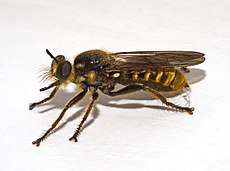
_by_Thomas_Shahan.jpg)
The head is free and mobile and dichoptic in both sexes and has three ocelli arranged in a characteristic depression formed by the elevation of the compound eyes. This feature is clearly visible in the front view and is a morphological peculiarity of Asilidae. The occipital region has one or more rows of bristles aligned behind the posterior margin of the eye. The facial region has a convex profile with a characteristic dense bundle of bristles, called a "mystax". The mystax helps protect the head and face when the fly encounters prey bent on defense. Other bristles are arranged on the ocellar tubercle.
The antennae are of the aristate type, composed typically of five segments but sometimes from three to four, depending on the structure of the stylus. The scape and pedicel are generally relatively short and hairy; the third segment (or first flagellomere) has an oval or oblong shape, is generally longer than the two basal segments, and bears a stylus generally composed of two segments, of which the basal is very short. In some asilids, the stylus can be monoarticolate or absent.

The mouthparts are short and modified for piercing-sucking. They consist of a strongly sclerotized proboscis which includes the labium and maxillae which form a food canal, the labrum and a piercing organ, the hypopharynx. The proboscis is rounded in cross section or laterally or dorsoventrally compressed and is usually stout, and straight and sometimes able to penetrate through the hard integument of Coleoptera. The maxillary palpi are at the base beside the labium, two-segmented in all Dasypogoninae or single segmented in Asilinae and Leptogastrinae.
The thorax is robust and compact. Unlike in other lower Brachycera it bears long bristles (macrochaeta) useful as taxonomic characters. Bristles of this type are always present on the notopleuron (notopleural bristles) and, in two series, on mesonotum (dorsocentral, supralar and postalar). Other bristles are present on the metanotum (dorsocentral bristles on the ventral episternum and at the apex of the mesoscutellum.
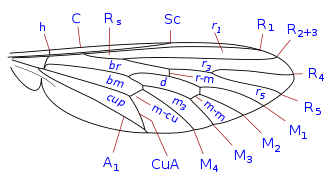
Longitudinal veins: C: costa; Sc: subcosta; R: radius; M: media; Cu: cubitus; A: anal.
Crossveins: h: humeral; r-m: radio-medial; m-m: medial; m-cu: medio-cubital.
Cells: d: discal; br: 1st basal; bm: 2nd basal; r1: marginal; r3: 1st submarginal; r5: 1st posterior; m3: 4th posterior; cup: cell cup.
The legs are relatively long and strong, with many macrochaetes performing a raptatorial function. The wings are well developed, often relatively narrow for speedy flight; the alula is generally well developed, with the exception of Leptogastrinae and part of Dasypogoninae. The venation is much as in Rhagionidae, Tabanidae and Therevidae; the radial R is always four-branched, with R2+3 unbranched. Details of wing venation determine subfamilies and lower taxa. The wings are most often hyaline, but sometimes smoky or dark colored, or partly infuscated in many genera or completely darkened.
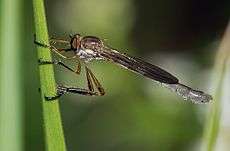
The abdomen consists of 6–8 visible segments preceding the genitalia in males, but the eighth segment is sometimes entirely or partially concealed, and terminal forming the ovipositor. It is long and narrow conical in most species but wide, dorsoventrally flattened and short in bee mimics. In Leptogastrinae the abdomen is extremely long and slender. In some tribes, the male undergoes axial torsion of 180 degrees.
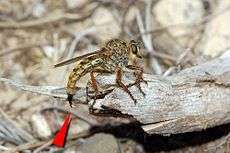
Egg
The egg is hyaline or pigmented and of variable shape from spherical to oval and up to 2 mm in length. The surface is smooth or bears microsculptures which are generally polygonal and visible only in the electron microscope.
Larva
The larva is apodous, cylindrical and elongated, more or less flattened dorso-ventrally and tapered at the cephalic and caudal ends. The colour is white or yellowish. The head is small, rugged, dark pigmented and hypognathous, the abdomen is composed of 8 apparent urites, with the last two often fused and more or less reduced. The respiratory system is amphineustic, with two pairs of spiracles, one thoracic and one abdominal. There are also rudimentary and nonfunctional stigmas in other abdominal segments.
Pupa
The pupa is naked, as in the majority of Orthorrhapha, exarate and therefore able to move.
Biology
The Asilidae are predators, both in the juvenile stage and the adult stage, and feed on small arthropods, mainly insects. Although predatory forms in the adult stage are present in other taxonomic groups of Diptera, the Asilidae are the most representative for the number of species and for uniformity of feeding behavior. They are aggressive to the point of earning the common name, in English, of "robber flies". The combination of high biodiversity and high predatory activity leads to this family playing an important role in the ecological stability of entomofauna.

The life cycle takes place in 1–3 years. The postembryonic development consists of four larval stages (instars) and one pupa. The larvae of the first instar differ from other stages in both ethology and trophic regime. The larvae of most known asilids live in the soil or in the case of some taxonomic groups, in rotting organic material, usually wood and the bark of dead trees. With regard to feeding behavior, most of the literature gives the larvae of the Asilidae as entomophagous, but there are doubts about the real nature of the trophic regime and its mechanisms. The entomophagy of some species had indeed been already hypothesized by some authors of the nineteenth century, based on the findings of larvae of asilids associated with larvae of other insects, but Melin (1923) asserted that, in reality, predation was occasional and secondary to the plant-based diet. More recent studies have confirmed the entomophagy of some asilids without extending this species's feeding behavior for the whole family. Less certain, however, is the mechanism of implementing entomophagy: in general, the behavior is cited as predation, but for some species may be ectoparasitoids. Musso (1983)[7] described the feeding behavior of the larvae of Machimus rusticus and its evolution during postembryonic development : in particular, the larvae of the first instar does not feed on insects, those of the second instar feed on secretions by larvae of beetles (and may cause death), while the larvae of the third and fourth instars actually behave like predators. In short, the feeding behavior of larval asilids can configure as intermediate between predation and ectoparasitism.
Much better known and described in detail is the behavior of adults. In general, the activity of predation of adults is concentrated in the hottest hours in open, sunny spaces, while at night they take refuge in dense vegetation. The Asilidae are excellent flyers and, in most of the family, capture prey in flight. They are often seen stationed to ambush prey at strategic points. This behavior signifies that sight plays an essential role in the detection of prey and their capture. The prey is caught with the tarsi and immobilized as a result of the paralysis caused by the injection of saliva. The asilid pierces the integument of the prey with the prepharyx (hyopharynx) in preferential points of least resistance as the eyes, the membranous area of transition between the head and thorax (neck) or between thorax and abdomen, or between the last urotergiti. Puncture is followed by the injection of saliva, whose active components perform two functions: the neurotoxins cause paralysis of the victim, while proteolytic enzymes lead to the breakup and liquefaction of internal tissues; in a short time the predator is able to feed by sucking the internal fluids through the alimentary canal.
With regard to interspecific trophic relationships, there is a large number of reports on the prey captured by Asilidae. Lavigne (2003) has developed a database comprising over 13,000 reports.[8] The prey of Asilidi are predominantly represented by other insects, mostly winged, but several cases in which they have attacked spiders have also been reported. Within the insects, orders that include the most frequent prey of asilids include a wide range of families within Coleoptera, Hymenoptera, other Diptera, Hemiptera, and Lepidoptera; prey belonging to various other orders (Odonata, Neuroptera, Isoptera, Thysanoptera, Blattodea, etc.) is also mentioned.
With regard to the specificity of the trophic relationship, Wood (1981)[2] mentions the existence of some studies in the literature on the subject. Some genera have been found to be monophagic, but more generally the Asilidae manifest a more or less wide polyphagia with behaviors that vary from stenophagia[8] to euriphagia.[2] However, there are cases of stenohage asilids which if necessary focus their predatory activity against a species when this forms large populations.
Other studies conducted by Dennis, D. and Lavigne,(1975)[9] have shown that the ratio between the size of the prey and the asilid varies from 1.8:1 to 3.7:1, with an average of 2.6:1. The ratio tends to increase with decreasing size of the predator.
Egg-laying takes place, according to the species, with three different behaviors which relate to the structure and the morphology of the abdomen. Females with an undifferentiated ovipositor release eggs randomly and independently from the substrate. In other cases, however, the abdomen bears a differentiated, specialized ovipositor to lay eggs in the soil or sand, or lay them in cavities within plant tissues.
Habitat and ecology
Asilidae generally occur in habitats that are open, sunny, and dry, even arid. They favour open or scattered vegetation, and some species even frequent bare ground. Typical habitats include savannah, forest steppe, open steppe, semi-desert, maquis shrubland, and related shrubland types such as fynbos and chaparral. Their biodiversity is lower in forested ecosystems and, where Asilidae do occur in such environments, they tend to concentrate in the glades and margins. In those conditions the interrupted canopy leaves space for various species of shrubs and herbaceous plants suited to Asilid styles of predation.
In general the biology of the Asilidae is still poorly known. However, various authors have studied the population distribution in particular regions and ecosystems. They have classified the behavioral patterns in terms of microenvironments, ecological, and trophic factors, showing how different species of Asilidae favour particular habitats suited to particular patterns of reproduction and predation. Specific studies show correlations between the floristic composition and predatory behaviour. Particularly seen in parts of Arizona including Sedona and Phoenix.[10]
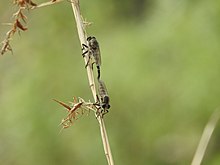
Distribution
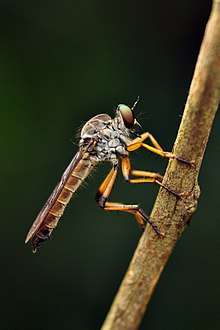
Asilidae occur in all zoogeographical regions except Antarctica. In the Northern Hemisphere, some species are even adapted to tundra. Alpine species occur at altitudes exceeding 4000 meters. However, the highest levels of biodiversity are in warm climates; tropical or subtropical and arid or semi-arid regions tend to have the greatest variety of species, followed by areas where rainfall is highly seasonal.
Systematics
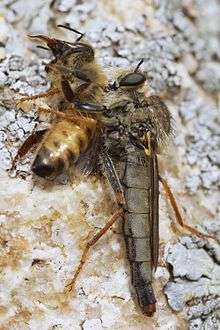
Asilidae currently includes over 7500 described species in about 556 genera.[11] The taxonomy is still under study in the light of new specimens and cladistic analysis. There are 14 accepted subfamilies:[12]
- Asilinae
- Bathypogoninae
- Brachyrhopalinae
- Dasypogoninae
- Dioctriinae
- Laphriinae
- Leptogastrinae
- Ommatiinae
- Phellinae
- Stenopogoninae
- Stichopogoninae
- Tillobromatinae
- Trigonomiminae
- Willistonininae
Phylogeny
| Asiloidea |
| |||||||||||||||
Clade showing relationship of Asiloidea
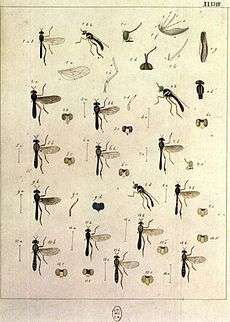
Notable researchers
Carl Linnaeus (Linné; 1758), in the tenth edition of Systema naturae, erected the genus Asilus, including 11 species, and added 4 others in the twelfth edition (1767). Asilus crabroniformis (1758) is the type of the genus. The rank of family is credited to Leach in Samouelle (1819). Johan Christian Fabricius in five publications dated from 1775 to 1805, erected the genus Damalis and described 76 exotic and European species. Wiedemann, in publications appearing between 1817 and 1830, described 235 species, many exotic. Johann Wilhelm Meigen in an early work of 1803 erected 4 genera, 3 of which now represent subfamilies. He also described many species in Systematische Beschreibung der bekannten europäischen zweiflügeligen Insekten (1800 to 1838). During the rest of the nineteenth century there were significant contributions by Hermann Loew in particular. Other prominent authors dealing with the Asilidae during the nineteenth century included Pierre-Justin-Marie Macquart, Francis Walker, Camillo Rondani and Jacques-Marie-Frangile Bigot.
See also
References
- http://www.geller-grimm.de/genera15.htm%5B%5D%5B%5D
- Wood, Grace C. (1981). "Asilidae" (PDF). In McAlpine, J. F.; Peterson, B. V.; Shewell, G. E.; Teskey, H. J.; Vockeroth, J. R.; Wood, D. M. (eds.). Manual of Nearctic Diptera. 1. Ottawa: Biosystematics Research Institute. pp. 549–73. ISBN 978-0-660-10731-8. Archived from the original (PDF) on 2016-11-04. Retrieved 2016-04-18.
- Jeffrey, Charles (1973). Biological nomenclature. London: Edward Arnold. ISBN 978-0-7131-2431-6.
- Robber fly eyes: http://www.bt-images.net/beautiful-eyes/robber-fly/ Archived 2014-04-23 at Archive.today
- Richards, O. W.; Davies, R. G. (1977). Imms' General Textbook of Entomology: Volume 1: Structure, Physiology and Development Volume 2: Classification and Biology. Berlin: Springer. ISBN 978-0-412-61390-6.
- https://cals.arizona.edu/yavapai/anr/hort/byg/archive/robberflies2014.html
- Musso, Joseph-Jean (1983). "Nutritive and Ecological Requirements of Robber Flies (Diptera: Brachycera: Asilidae)". Entomologia Generalis. 9 (1–2): 35–50. doi:10.1127/entom.gen/9/1983/35.
- "Database Asilidae: predator-prey database". www.geller-grimm.de.
- Dennis, D Steve; Lavigne, Robert J (1975). Comparative behavior of Wyoming robber flies II (Diptera: Asilidae). Laramie: Agricultural Experiment Station, University of Wyoming. OCLC 10795887.
- "Fritz Geller-Grimm. Information on Robber Flies: Ecological Classification in Robber flies (Asilidae)".
- "Asiloid Flies: Asilidae". asiloidflies.si.edu. Smithsonian Institution. Retrieved 10 January 2017.
- Dennis, D. Steve; Barnes, Jeffrey K.; Knutson, Lloyd (17 June 2013). "Review and analysis of information on the biology and morphology of immature stages of robber flies (Diptera: Asilidae)". Zootaxa. 3673 (1): 1–64. doi:10.11646/zootaxa.3673.1.1. PMID 26146701.
Further reading
- Geller-Grimm F (2003): Photographic atlas and identification key to the robber flies of Germany (Diptera: Asilidae), CD-ROM, Amphx-Verlag Halle (Saale). ISBN 3-932795-18-0
- Hull, Frank M. (1962). "Robber Flies of the World: The Genera of the Family Asilidae". Bulletin of the United States National Museum. 224 (224): 1–907. doi:10.5479/si.03629236.224. hdl:10088/10126.
- Lavigne, Robert J. (2003). "Evolution of courtship behaviour among the Asilidae (Diptera), with a review of courtship and mating". Studia Dipterologica. 9 (2): 703–42.
- Musso, Joseph-Jean (1978). Recherches sur le développement, la nutrition et l'écologie des Asilidae (Diptera - Brachycera) [Development research, nutrition and ecology of Asilidae (Diptera - Brachycera)] (PhD thesis) (in French). OCLC 30534417.
- Oldroyd, Harold (1969). Tabanoidea and Asiloidea. Handbooks for the identification of British insects. Royal Entomological Society. OCLC 256410648.
- Papavero, Nelson (1973). "Studies of Asilidae (Diptera) systematics and evolution: I. A preliminary classification in subfamilies". Arquivos de Zoologia. 23 (3): 217–74. doi:10.11606/issn.2176-7793.v23i3p217-274.
External links
| Wikimedia Commons has media related to Asilidae. |
| Wikispecies has information related to Asilidae |
- Database service for Asilidae – Robber flies Comprehensive overview by Fritz Geller-Grimm, Torsten Dikow and Robert J. Lavigne
- Asiloid Flies: Deciphering their diversity and evolutionary history Smithsonian National Museum of Natural History.
- West Palaearctic species including Russia
- Australasian/Oceanian species
- Nearctic species
- Japan species
- World list species
- Robber flies of North America – reference photographs, descriptions, natural history
- Family Asilidae at Bugguide.net Images
- Family Asilidae at EOL Images
- Atlas of German Asilidae
- Key to the Asilidae of Central Europe
- Images (text in Japanese)
- Diptera.info
- Family description and images
- robber flies on the UF / IFAS Featured Creatures Web site
- bee killers, Mallophora spp. on the UF / IFAS Featured Creatures Web site
- Courting-dance of the robber fly (gallery)
- Robberflies of Germany Excellent. Includes structure.
- Wing venation
- Family Asilidae at EOL Images. Flowers visited by adults.